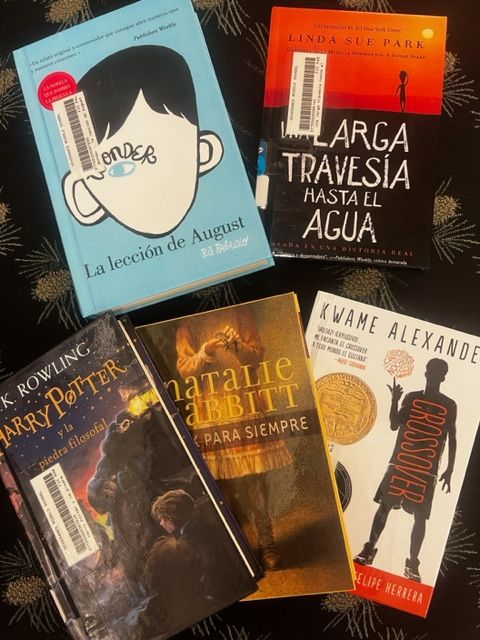By: Lindsay Bohlinger
The month of April is dedicated to school libraries and celebrating all the great things our libraries provide for students and schools. When did you last spend some quality time in your library to walk the shelves to see what they have to offer? Do you have a diverse collection? Fantasy, Non-fiction, Graphic Novels, Mystery, Thrillers? What about books for your multilingual students?
things our libraries provide for students and schools. When did you last spend some quality time in your library to walk the shelves to see what they have to offer? Do you have a diverse collection? Fantasy, Non-fiction, Graphic Novels, Mystery, Thrillers? What about books for your multilingual students?
Over the course of several years we have seen a significant increase in multilingual students in our district. As the school librarian, I wanted to make sure that they had the same opportunity to read books in class with their peers or in their free time. There is something special about getting lost in another world when the world around us seems too chaotic. Every child deserves to see themselves in a book, or to connect to a character in a special way. Students that are multilingual deserve to find peace and comfort in a world with a language they understand.
This year I have spent a lot of time updating and curating new school library resources that meet the needs of our ever-changing student population. One of my big pushes was to beef up our Spanish book selection for students who are multilingual. I spent time looking at the statistics, gathering evidence, and asking teachers for input on what to include in this part of our library.
Statistics
1 in 4 students is hispanic (Hispanic Research Center, 2022). There are an estimated 18.6 million Hispanic students and 3.8 million are native speakers who are not proficient in English (Hispanic Research Center, 2022). This number continues to grow and our schools aren’t always prepared to help these students succeed. Hispanic students are twice as likely to drop out of school compared to their caucasian peers.
Evidence
Studies have shown that when students are able to read in their first language they have an easier time reading in a second language (Alford, 2021). This also allows them to become more proficient readers in a second language even if they are learning new letters and sounds because they understand the process of reading (Alford, 2021). Furthermore, according to the Association for Childhood Education, students that are exposed to reading in their first language develop stronger pre-literacy skills than if they are only exposed to books in their second language (Association for Childhood Education International, 2003).
Teacher Input/Feedback
I asked my language arts teachers in particular what books they would like in our library for our multilingual students throughout the fall semester in order to make sure I was going to get books that our students would enjoy and be able to use in class with their peers (class sets). I also asked for input from other content teachers and our multilingual teacher to see if they had any suggestions and to make sure I was including a variety of subject areas for students to choose and learn from.
I wanted to make sure that students had access to topics that would interest them so I made sure to include sports books, fantasy books, classics, picture books, and a few other non-fiction stories. These are the same topics I would include for other demographics too. The data in my school library shows that 60% of my checkouts come from these categories, so I know that these topics are popular for students of any language background.
My selection of Spanish books doubled in size this year after doing research on the need for these books so multilingual students could feel not only successful, but like they have a place in the library to enjoy and escape the chaos around them. The checkouts of these new spanish books has gone from 5 checkouts of the same three books from last year to 26 this year of our various new books. The time and effort put into understanding the needs of my multilingual students has truly paid off, and my hope is checkouts and new books will continue to grow in our library to meet the needs of my students over the next several years.
Lindsay Bohinger is the learning coach and librarian at Severance Middle School in the Weld-RE 4 School District. She enjoys hiking, running, and hanging out with her family when her nose isn’t stuck in a book.
Sources
Alford, Jennifer H. “Enacting Critical Literacy with Adolescent English as an Additional Language Learners.” Critical Literacy with Adolescent English Language Learners, 2021, pp. 117–172., https://doi.org/10.4324/9781315617923-4.
Authors: et al. “Latino Children Represent over a Quarter of the Child Population Nationwide and Make up at Least 40 Percent in 5 Southwestern States.” Hispanic Research Center, 2 Aug. 2022, https://www.hispanicresearchcenter.org/research-resources/latino-children-represent-over-a-quarter-of-the-child-population-nationwide-and-make-up-at-least-40-percent-in-5-southwestern-states/.
Breiseth, Lydia. “Why Reading to Your Kids in Your Home Language Will Help Them Become Better Readers.” Colorín Colorado, Colorín Colorado, 8 Mar. 2023, https://www.colorincolorado.org/article/why-reading-your-kids-your-home-language-will-help-them-become-better-readers.
Gramlich, John. “Hispanic Dropout Rate Hits New Low, College Enrollment at New High.” Pew Research Center, Pew Research Center, 29 July 2020, https://www.pewresearch.org/fact-tank/2017/09/29/hispanic-dropout-rate-hits-new-low-college-enrollment-at-new-high/.
Lam, Kristin, and Erin Richards. “More US Schools Teach in English and Spanish, but Not Enough to Help Latino Kids.” USA Today, Gannett Satellite Information Network, 24 May 2020, https://www.usatoday.com/in-depth/news/education/2020/01/06/english-language-learners-benefit-from-dual-language-immersion-bilingual-education/4058632002/.

